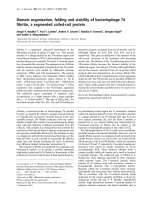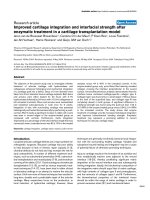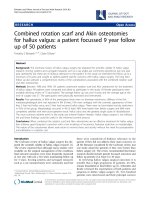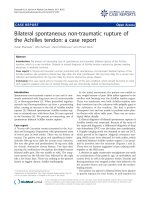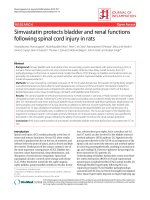Báo cáo y học: "Extrapyramidal side effects and suicidal ideation under fluoxetine treatment: a case repot" pps
Bạn đang xem bản rút gọn của tài liệu. Xem và tải ngay bản đầy đủ của tài liệu tại đây (170.19 KB, 3 trang )
CAS E REP O R T Open Access
Extrapyramidal side effects and suicidal ideation
under fluoxetine treatment: a case report
Christos Christodoulou
1*
, Athanasia Papadopoulou
1
, Emmanouil Rizos
1
, Kalliopi Tournikioti
1
, Xenia Gonda
2
,
Athanassios Douzenis
1
, Lefteris Lykouras
1
Abstract
Background: We present the case of a 52-year-old woman with depression who developed extrapyramidal
symptoms (mainly parkinsonism) and suicidal ideation while on fluoxetine.
Methods: The patient underwent neurological and neuroimaging examination.
Results: The patient’s neurological and neuroimaging examinations were normal and there was no other cause of
extrapyramidal symptoms. The patient showed remission of the aforementioned symptomatology when fluoxetine
was discontinued.
Conclusions: This case shows that fluoxetine can be associated with extrapyramidal symptoms, and this may have
an aggravating affect on clinical depression progress and the emergence of suicidal ideation.
Background
Extrapyramidal symptoms (EPSs) are an uncommon side
effect of serotonin reuptake inhibitors (SSRIs). Concomi-
tant use with antipsychotic medicat ion or the presence
of other risk factors (age, gender) increase the vulner-
ability to EPSs [1]. The most common EPS associated
with SSRIs seems to be akathisia, followed by dystonia
and parkinsonism. Fluoxetine is the SSRI most asso-
ciated with extrapyramidal reactions in the majority of
cases [2,3]. Even, in adolescents treated with fluoxetine,
EPSs have been reported [4]. The symptoms are reversi-
ble with dose reduction, drug discontinuation, or by the
addition of another agent, such as anticholinergic
agents, b-blockers or benzodiazepines [5,6]. EPSs, and
especia lly akathisia, have been associated with the emer-
gence of suicidal ideation and suicidal acts in patients
receiving fluoxetine [7,8], however, a clear relationship
between fluoxetine and emerging suicidality is not cer-
tain [9].
We present t he case of a female receiving fluoxetine
who, after approximately 1 month of therapy, developed
severe EPSs, mainly parkinsonism, with simultaneous
emergence of suicidal ideation.
Case presentation
A 52-year-old marrie d woman presented to the emer-
gency department of the Psychiatric Clinic of ‘Attikon’
General Hospital in Athens with depressive sym ptoms.
The symptoms had begu n 1 month prior to the referral
to our hospital, and included: depressive mood, insom-
nia, early morning waking, loss of appetite and psycho-
motor retardation. At that time she visited a p rivate
psychiatrist, and was given antidepressant therapy wit h
fluoxetine, 60 mg per day and alprazolam 1.5 mg daily
for 4 weeks with no significant improvement. During
her examination, she was obviously very depressed and
anxious with no psychotic symptoms and she reported
suicidal ideation for the last 10 days.
Her neurological examin ation revealed severe rigidity
and bradykinesia. Her face was like a ‘ mask ’ and her
facial movements were almost non-existent. She was
speaking at low volume but she had no rest or move-
ment tremor, and no severe instability. Clinically,
although her treatment did not include any antipsycho-
tic drugs, her appearance did n ot differ from typical
antipsychotic-induced parkinsonism. Her husband had
observed reduced facial expression for the last 2 weeks.
The patient herself associated her suicidal ideation with
the subjective sensation of a progressive movement dis-
ability. Her medical history revealed no neurological
* Correspondence:
1
Second Department of Psychiatry, Athens University Medical School,
‘Attikon’ General Hospital, Athens, Greece
Christodoulou et al. Annals of General Psychiatry 2010, 9:5
/>© 2010 Christodoulou et al; licensee BioMed Central Ltd. This is an Open Access article distributed under the terms of the Creative
Commons Attr ibution License ( which permits unrestricted use, distribution, and
reproduction in any medium, provided the original work is properly cited.
diseases. A magnetic resonance imaging (MRI) scan
showed no abnormal findings.
It was recommended that fluoxetine treatment be
stopped and alprazolam continued.
Results
At 1 week later the improvement of her rigidity and
bradykinesia was impressive. Her facial expression was
almost normal. The emotional distress was re duced and
surp risingly her suicidal ideation diminished with fluox-
etine withdrawal. At that time she was given another
class of antidepressant, showing significant improvement
of her depression.
Discussion
Considerable controversy exists regarding the relation-
ship between fluoxetine and the emergence of suicidal
ideation. Our patient had no neurological history. EPSs,
mainly parkinsonism, had appeared in the last 2 weeks
while she had been under medication with fluoxetine.
Several reports published i n the 1 990s suggested that
fluoxetine could be responsible for suicidal ideation or
behav iour [7,10-12]. More recent studies have suggested
this relationship as well. In a case-control analysis an
association has been found between SSRIs and suicide
events [13]. Moreover, a sy stematic review of rando-
mised controlled trials supports the relationship between
the use of SSRIs and the increased risk of suicidal beha-
viour. According to this review, such risk may be under-
estimated due to a number of methodological
limitations of the published reports [14].
By contrast, the results of a recent cohort study based
on a large sample do not support the h ypothesis that
treatment with SSRIs increases the risk of suicide [15].
In another matched case-control study, the risk of suici-
dal behaviour was reported to be similar among users of
amitriptyline, fluoxetine and paroxetine [16]. Also, a
nationwide cohort study in Finland found that fluoxe-
tine was associated with a lower risk of suicide among
different classes of antidepressants. Moreover, the
results of the same study indicate that the current use
of any antidepressant among suicidal patients was asso-
ciated with increased risk of attempted suicide by self-
poisoning, but with a decreased risk of completed sui-
cide and death. The latter could be attributed to the
fewer cardiovascular and cere brovascular side effects of
SSRI medication [17]. Finally, a meta-analysis of rando-
mised control trials of SSRIs conducted by pharmaceuti-
cal companies indicated that there is evidence of
increased risk of non-fatal self-harm in adults treated
with SSRIs but no evidence of increased risk of suicidal
thoughts [18].
Akathisia or dysphoric extrapyramidal reactions may
be a contributing factor to the emergence of suicidal
ideation during treatment with fluoxetine [19]. In our
case, parkinsonism and restlessness (but no akathisia)
were prominent in the clinical picture of the patient.
EPSs may have accidentally appeared in our patient, or
an underlying organic disorder may have predisposed
her t o EPSs. However, an MRI scan revealed no abnor-
mal findings that could explain a possible vulnerability
to side effects. After stopping fluoxetine, the patient’s
extrapyramidal symptomatology improved dramatically
as did her suicidal thoughts. This report suggests that
severe EPSs, and in particular parkinsonism due to the
implicated movement disability, cause distress, which in
turn may cause suicidal ideation.
Conclusions
It is possible that SSRI as monotherapy could be the
cause of EPSs and subsequent suicidal ideation. Psychia-
trists must be aware of this side effect and be prepared
for clinical fea tures characterised by movement disor-
ders in patients treated with SSRIs.
Consent
Written informed consent was obtained from the patient
for publication of this case report and any accompany-
ing images. A copy of the written consent is available
for review from the Editor-in-Chief of this journal.
Author details
1
Second Department of Psychiatry, Athens University Medical School,
‘Attikon’ General Hospital, Athens, Greece.
2
Department of Clinical and
Theoretical Mental Health, Kutvolgyi Clinical Center, Semmelweis University,
Faculty of Medicine, Budapest, Hungary.
Authors’ contributions
CC made substantial contributions to the conception and design of the
present study, and was also involved in drafting and revising the manuscript
and gave final approval for the manuscript to be published. AP was
codesigner of the present study and made substantial contributions in the
acquisition, analysis and interpretation of the data. ER made substantial
contributions in drafting the manuscript and revising it critically for
intellectual content. KT contributed to the clinical evaluations and
manuscript drafting. XG and AD made substantial contributions in revising
the manuscript. LL made substantial contributions in drafting the manuscript
and revising it critically for intellectual content, and gave final approval for
the manuscript to be published. All authors read and approved the final
manuscript.
Competing interests
The authors declare that they have no competing interests.
Received: 4 November 2009
Accepted: 18 January 2010 Published: 18 January 2010
References
1. Schillevoort I, van Puijenbroek EP, de Boer A, Roos RA, Jansen PA,
Leufkens HG: Extrapyramidal syndromes associated with selective
serotonin reuptake inhibitors: a case-control study using spontaneous
reports. Int Clin Psychopharmacol 2002, 17:75-79.
2. Coulter DM, Pillans PI: Fluoxetine and extrapyramidal side effects. Am J
Psychiatry 1995, 152:122-125.
Christodoulou et al. Annals of General Psychiatry 2010, 9:5
/>Page 2 of 3
3. Leo R: Movements disorders associated with serotonin selective
reuptake inhibitors. J Clin Psychiatry 1996, 57:449-454.
4. Diler RS, Yolga A, Ausi A: Fluoxetine-indused extrapyramidal symptoms in
an adolescent: a case report. Swiss Med Wkly 2002, 132:125-126.
5. Leo R: Movement disturbances associated with the use of selective
serotonin-reuptake inhibitors. Ann Pharmacother 1998, 32:712-714.
6. Lavin MR, Mendelowitz A, Block SH: Adverse reaction to high-dose
fluoxetine. J Clin Psychopharmacol 1993, 13:452-453.
7. Rothschild A, Locke C: Reexposure to fluoxetine after serious attempts by
three patients: the role of akathisia. J Clin Psychiatry 1991, 52:491-493.
8. Wirshing W, van Putten T, Rosenberg J, Marder S, Ames D, Hicks-Gray T:
Fluoxetine, akathisia, and suicidality: Is there a causal connection?. Arch
Gen Psychiatry 1992, 49:580-581.
9. Crundwell JK: Fluoxetine and suicidal ideation-a review of the literature.
Int J Neurosci 1993, 68:73-84.
10. Teicher M, Glod C, Cole J: Emergence of intense suicidal preoccupation
during fluoxetine treatment. Am J Psychiatry 1990, 147:207-210.
11. Teicher MH, Glod CA, Cole JO: Antidepressant drugs and the emergence
of suicidal tendencies. Drug Safety 1993, 8:186-212.
12. Ratan D: Fluoxetine and suicidal ideation. J Clin Psychopharmacol 1997,
17:61-62.
13. Marangell LB, Dennehy EB, Wisniewski SR, Bauer MS, Miyahara S, Allen MH,
Martinez M, Al Jurdi RK, Thase ME: Case-control analyses of the impact of
pharmacotherapy on prospectively observed suicide attempts and
completed suicide I bipolar disorder: findings from STEP-BD. J Clin
Psychiatry 2008, 69:916-922.
14. Fergusson D, Doucette S, Granley Glass K, Shapiro S, Healy D, Hebert P,
Hutton B: Association between suicide attempts and selective serotonin
reuptake inhibitors: systematic review of randomised controlled trials.
BMJ 2005, 19:1-7.
15. Gibbsons R, Brown C, Hur K, Marcus S, Bhaumik D, Mann J: Relationship
between antidepressants and suicide attempts: an analysis of the
veteran health administration data sets. Am J Psychiatry 2007, 164:1044-
1049.
16. Jick H, Kaye J, Jick S: Antidepressant and the risk of suicidal behaviours. J
Am Med Assoc 2004, 292:338-343.
17. Tiihonen J, Lönnqvist J, Wahlbeck K, Klaukka T, Tanskanen A, Haukka J:
Antidepressants and the risk of suicide, attempted suicide, and overall
mortality in a nationwide cohort. Arch Gen Psychiatry 2006, 63:1358-1367.
18. Gunnell D, Saperia J, Ashby D: Selective serotonin reuptake inhibitors
(SSRIs) and suicide in adults: meta-analysis of drug company data from
placebo controlled, randomized controlled trials submitted to the
MHRA’s safety review. BMJ 2005, 330:1-5.
19. Hamilton MS, Opler LA: Akathisia, suicidality, and fluoxetine. J Clin
Psychiatry 1992, 53:401-406.
doi:10.1186/1744-859X-9-5
Cite this article as: Christodoulou et al.: Extrapyramidal side effects and
suicidal ideation under fluoxetine treatment: a case report. Annals of
General Psychiatry 2010 9:5.
Publish with Bio Med Central and every
scientist can read your work free of charge
"BioMed Central will be the most significant development for
disseminating the results of biomedical research in our lifetime."
Sir Paul Nurse, Cancer Research UK
Your research papers will be:
available free of charge to the entire biomedical community
peer reviewed and published immediately upon acceptance
cited in PubMed and archived on PubMed Central
yours — you keep the copyright
Submit your manuscript here:
/>BioMedcentral
Christodoulou et al. Annals of General Psychiatry 2010, 9:5
/>Page 3 of 3
